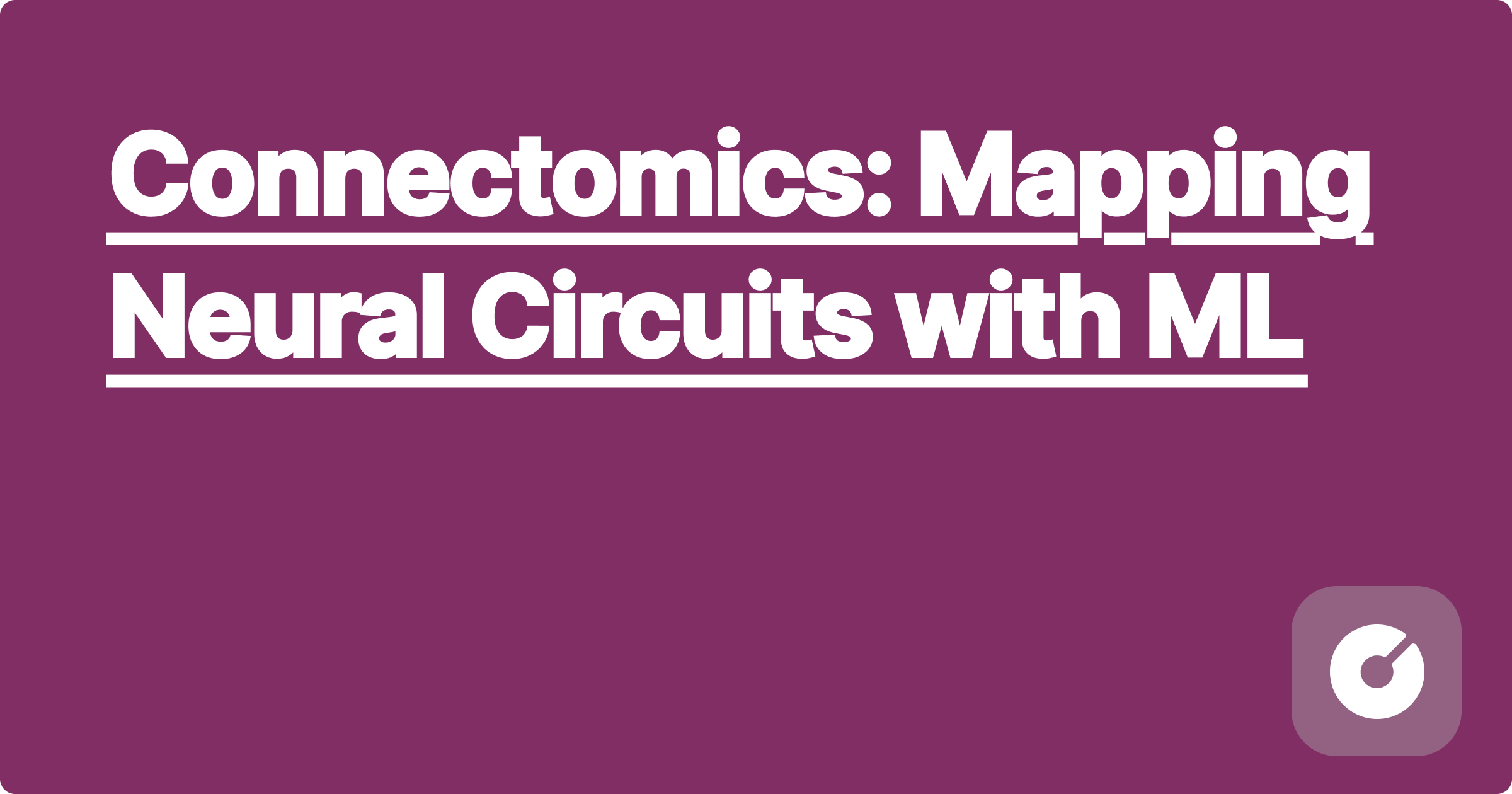
This blog post delves into the cutting-edge field of connectomics, focusing on the crucial role of machine learning (ML) in mapping neural circuits. We will cover the latest advancements, practical implementation details, and future directions, aiming to provide a comprehensive resource for graduate students and researchers actively working in this area.
The field of connectomics has witnessed explosive growth, fueled by advancements in both microscopy techniques (e.g., serial block-face scanning electron microscopy (SBEM), array tomography) and computational methods. Recent breakthroughs are pushing the boundaries of what's possible, allowing us to map increasingly larger and more complex neural circuits.
While supervised learning has been dominant in connectomics, the reliance on large, manually annotated datasets presents a significant bottleneck. Unsupervised and self-supervised learning methods are emerging as promising alternatives. For example, the work presented in "Learning the Structure of Neuronal Networks using Self-Supervised Learning" (pre-print, bioRxiv, 2024) demonstrates the effectiveness of contrastive learning in segmenting and reconstructing neuronal structures without human annotations. This approach leverages inherent structural features in electron microscopy images to learn representations that accurately capture neuronal morphology.
GNNs are revolutionizing connectome analysis by effectively modeling the complex graph-like structure of neural circuits. Recent research published in *Nature Methods* (2025) shows how GNNs can be used to predict functional connectivity from structural connectomes with remarkable accuracy. The key innovation lies in incorporating both topological and spatial information into the graph representation, allowing the GNN to capture nuanced relationships between neurons.
Integrating data from different modalities, such as electrophysiology, calcium imaging, and gene expression, significantly enhances our understanding of neural circuit function. Current research focuses on developing sophisticated ML models that can fuse these diverse datasets, offering a more holistic view of brain circuitry. For instance, the Allen Brain Institute's ongoing project, "Bridging the Gap: Integrating Connectomics with Functional Data," aims to create a comprehensive, multi-modal atlas of the mouse brain.
This section dives into the technical details of implementing ML-based connectomics pipelines.
A crucial step in connectomics is segmenting neuronal structures from electron microscopy images. Advanced CNN architectures, such as U-Net and its variants (e.g., Attention U-Net), have shown superior performance in this task.
Once neuronal structures are segmented, they need to be represented as a graph. This involves identifying synapses and creating connections (edges) between neurons (nodes). Advanced graph algorithms are then used to analyze this connectome graph, such as community detection to identify functionally distinct modules.
Let's consider a simplified model of synaptic connections. We can represent the connectome as an adjacency matrix \(A \in \mathbb{R}^{N \times N}\), where \(N\) is the number of neurons. \(A_{ij} = 1\) if there's a synapse from neuron \(i\) to neuron \(j\), and 0 otherwise. The degree of a neuron (number of connections) is given by \(d_i = \sum_{j=1}^N A_{ij}\). We can analyze network properties using various graph metrics, such as clustering coefficient, path length, and modularity. Calculating the modularity \(Q\) involves optimizing a function that balances the number of intra-community edges and inter-community edges.
\(Q = \frac{1}{2m} \sum_{ij} [A_{ij} - \frac{k_i k_j}{2m}] \delta(c_i, c_j)\)
where \(m\) is the total number of edges, \(k_i\) and \(k_j\) are the degrees of nodes \(i\) and \(j\), and \(\delta(c_i, c_j)\) is 1 if nodes \(i\) and \(j\) belong to the same community, and 0 otherwise.
Analyzing large connectomes presents significant computational challenges. The complexity of many graph algorithms scales poorly with the number of nodes and edges. Memory requirements can also be substantial, particularly when dealing with high-resolution microscopy data. Employing techniques like distributed computing and efficient data structures is crucial for handling large-scale connectomes.
Several open-source tools and libraries facilitate connectomics research, including:
* **Vaa3D:** A versatile software package for visualizing and analyzing 3D microscopy images.
* **Neuroglancer:** A web-based viewer for large-scale neuroimaging data.
* **Python libraries (scikit-learn, TensorFlow, PyTorch):** Essential for building and training ML models.
Tip: Leverage cloud computing platforms (e.g., AWS, Google Cloud) for efficient processing of large datasets.
Industrial applications of connectomics include:
* **Neuromorphic computing:** Designing next-generation computers inspired by the brain's architecture. Companies like Intel and IBM are investing heavily in this area.
* **Drug discovery:** Identifying potential drug targets based on connectome analysis. Pharmaceutical companies are increasingly utilizing this approach.
* **Brain-computer interfaces:** Developing advanced BCIs that require detailed understanding of neural circuits. Neuralink is a prominent example.
Current challenges include:
* **Scaling up to larger volumes:** Mapping the entire human brain remains a significant hurdle.
* **Improving annotation accuracy:** Manual annotation is time-consuming and prone to errors.
* **Understanding functional connectivity:** Relating structural connectomes to functional brain activity remains a major challenge.
Future directions include:
* **Developing more robust and efficient ML models:** Addressing limitations of current algorithms.
* **Integrating multi-modal data:** Combining different types of data to create more complete models of brain function.
* **Developing novel visualization and analysis techniques:** Making connectome data accessible and interpretable.
Warning: The ethical implications of accessing and manipulating brain data must be carefully considered. Data privacy and security are paramount.
Connectomics, powered by ML, is rapidly transforming our understanding of the brain. By combining advanced microscopy techniques with sophisticated computational methods, we are making significant strides in mapping neural circuits. However, many challenges remain, demanding innovative approaches and interdisciplinary collaborations. The future of connectomics promises exciting breakthroughs that will have a profound impact on neuroscience, medicine, and technology. This blog post provides a foundation for further exploration and encourages readers to contribute to this dynamic and impactful field.
```html
```
Anesthesiology Career Path - Behind the OR Mask: A Comprehensive Guide for Pre-Med Students
Internal Medicine: The Foundation Specialty for a Rewarding Medical Career
Family Medicine: Your Path to Becoming a Primary Care Physician
Psychiatry as a Medical Specialty: A Growing Field Guide for Aspiring Physicians
Connectomics: Mapping Neural Circuits with ML
Duke Machine Learning GPAI Demystified Neural Network Training | GPAI Student Interview
Neural Network Hardware Engineering AI Chips - Complete Engineering Guide
AI-Driven Spatial Statistics: Geographic Data Analysis and Mapping
AI-Powered Quantum Neural Networks: Quantum-Classical Hybrids